
High school students who are graduating this year and getting ready to enter college face a higher education system that still hasn't rebounded from the budget cuts of the Great Recession.
Every state except for North Dakota and Wyoming has cut funding for higher education since 2008, and nationwide state spending for public colleges is down 28 percent in the 2013 fiscal year, according to an analysis by the Center on Budget and Policy Priorities. Eleven states trimmed financial support per student by one-third, and Arizona and New Hampshire chopped higher education spending per student in half, the analysis found.
The lack of financial support contributed to rising tuition costs, the CFBP found. As a result, 2013 college graduates are the most indebted class yet.
Younger students have taken a hit too. For K-12 education, the U.S. Census Bureau announced this month that per-pupil spending fell in 2011 for the first time in almost four decades.
"This is clearly the fallout from the Great Recession," Michael Petrilli, executive vice president of The Thomas B. Fordham Institute, a conservative education think tank, told NBC's Today Show.
The Wall Street Journal reports that some states are showing signs of once again investing in higher education:
Lawmakers in Indiana recently approved a $500 million funding increase over two years for state colleges and universities, a 14.6% increase, following four years of cuts. New Hampshire's governor has proposed increasing the university budget for the coming academic year by $20 million, or 37%. And state lawmakers in Florida recently approved a budget that increases higher-education funding by $314 million, or 8.3%, following seven years of cuts.
In the K-12 arena, Minnesota Gov. Mark Dayton (D) signed a bill last week that significantly bosts funding for public education. California schools are getting more cash this year after voters increased taxes on the wealthy in 2012, although Gov. Jerry Brown (D) is facing a battle over a plan to give more money to districts with low-income families.
The increased support for public education is a result of stronger state tax revenues, which suffered an unprecedented drop in the Great Recession.
"This will be the first year in which states will be back to their pre-recession budget levels," Scott Pattison of the National Association of State Budget Officers told NPR. However, it remains to be seen whether the money will in fact return to elementary and secondary schools and public colleges.
If the funding doesn't increase, public universities may continue to respond to decreased appropriations with tuition hikes.

